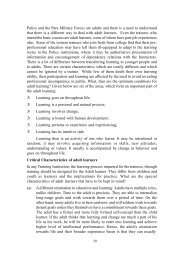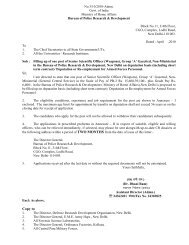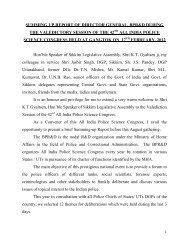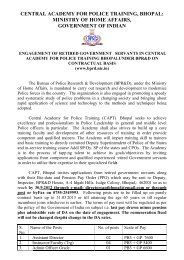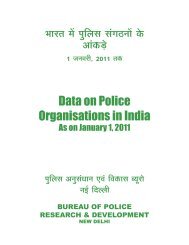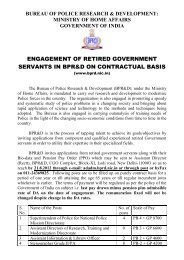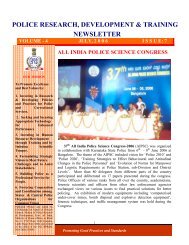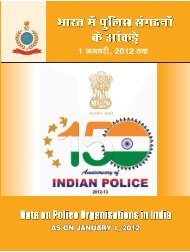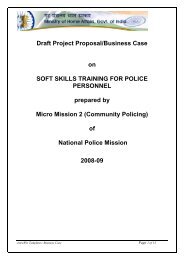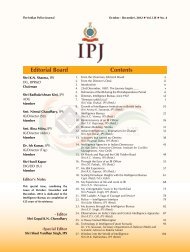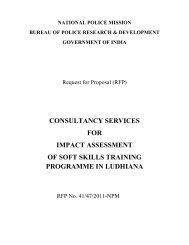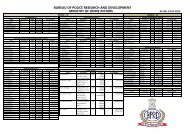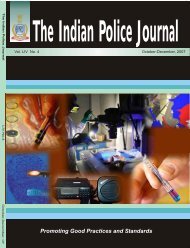April - June 2010 - Bureau of Police Research and Development
April - June 2010 - Bureau of Police Research and Development
April - June 2010 - Bureau of Police Research and Development
- No tags were found...
Create successful ePaper yourself
Turn your PDF publications into a flip-book with our unique Google optimized e-Paper software.
Conviction Rate : A Reality CheckFrom the above figures, it becomes clearthat, on an average, a case instituted inthe year 1980 was sent up for trial in1981, trial proceedings were completedon an average in the year 1988 <strong>and</strong> appealsfiled by the accused persons were decidedin the year 1998. And then came the revisions.All eight revisions, 5 filed by the accused<strong>and</strong> 3 by the State, are still pending inthe High Court. Not even one has beendecided so far.There is another way <strong>of</strong> looking at thesefigures. Data pertains to the year 1980to 1984. The mean year is 1982. Thus,on an average, cases are already 26years old. Even if, it is presumed thatthe age <strong>of</strong> an accused public servantwas only 35 years when FIR was registeredagainst him, he would have retired bynow !In all, two convicted accused personsunderwent prison sentence after the trialcourt verdict. One more did so afterthe appellate court upheld the sentence,However, the above figures regardingtime taken at various stages would showthat had these three gentlemen decidedto contest the judgement <strong>of</strong> the trialcourt or the appellate court, as the casemay be, <strong>and</strong> filed appeals/revisions, thesame would not have been decided eventill date i.e. year 2008. This shows thateven 26 years are NOT enough for lawto complete its course. It appears thatpeople who actually undergo sentencesare those who get tired out in the legalbattle or lack the resources to fight(or are simply FOOLS !)Does Section 389(3) Cr.P.C. Influencesentencing?Following table shows sentence-wise breakup <strong>of</strong> convictions:-Table-3: Sentencewise Breakup <strong>of</strong> ConvictionYear No. <strong>of</strong> Sentenced Sentencedconvicted to 3 years to moreaccused or less than 3years.1980 19 19 Nil1981 34 29 051982 33 22 091983 40 36 041984 18 16 02Total: 144 122 20Only 20 <strong>of</strong> the 144 convicted accused weresentenced to more than 3 years, which is ameager 13.89% <strong>of</strong> the total. This suggests thatCourts apparently do keep Section 389(3) Cr.P.Cin mind while awarding sentences. This factfurther highlights the need for formulatingsentencing guidelines.Implications <strong>of</strong> such leniency are very serious.Accused knows that more than 85% (17 out <strong>of</strong> 20)chances are that he will not have to spend timein jail even if convicted <strong>and</strong> then will also have theluxury <strong>of</strong> filing· appeal, followed by revision <strong>and</strong>followed by another appeal <strong>and</strong> so on, till he diesor gets too old for the court to impose anymeaningful sentence. The more he prolongs the trial,more are the chances <strong>of</strong> success !Judiciary <strong>of</strong>ten holds poor investigation as themother <strong>of</strong> all ills, including low convictionrate. However, in the 144 instances when theaccused were convicted by the trial court,nothing stopped the courts from awardingexemplary penalties. Instead, only 2030 ➢ The Indian <strong>Police</strong> Journal Vol. LVII-No. 2, <strong>April</strong>-<strong>June</strong>, <strong>2010</strong>



